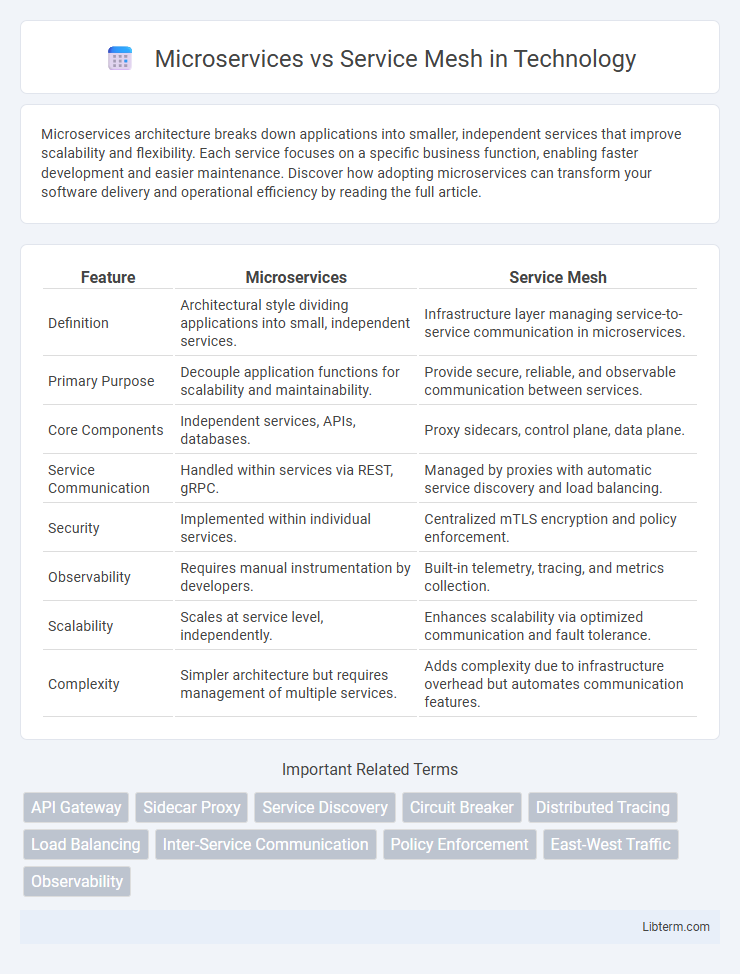Microservices architecture breaks down applications into smaller, independent services that improve scalability and flexibility. Each service focuses on a specific business function, enabling faster development and easier maintenance. Discover how adopting microservices can transform your software delivery and operational efficiency by reading the full article.
Table of Comparison
| Feature | Microservices | Service Mesh |
|---|---|---|
| Definition | Architectural style dividing applications into small, independent services. | Infrastructure layer managing service-to-service communication in microservices. |
| Primary Purpose | Decouple application functions for scalability and maintainability. | Provide secure, reliable, and observable communication between services. |
| Core Components | Independent services, APIs, databases. | Proxy sidecars, control plane, data plane. |
| Service Communication | Handled within services via REST, gRPC. | Managed by proxies with automatic service discovery and load balancing. |
| Security | Implemented within individual services. | Centralized mTLS encryption and policy enforcement. |
| Observability | Requires manual instrumentation by developers. | Built-in telemetry, tracing, and metrics collection. |
| Scalability | Scales at service level, independently. | Enhances scalability via optimized communication and fault tolerance. |
| Complexity | Simpler architecture but requires management of multiple services. | Adds complexity due to infrastructure overhead but automates communication features. |
Introduction to Microservices and Service Mesh
Microservices architecture breaks down applications into independent, loosely coupled services that focus on specific business functionalities, enhancing scalability and agility. Service mesh is an infrastructure layer managing inter-service communication, providing features like load balancing, security, and observability without altering application code. Combining microservices with a service mesh improves reliability and operational control in complex distributed systems.
Core Concepts: Microservices Architecture
Microservices architecture divides applications into small, independent services that communicate over well-defined APIs, enabling scalability and agility. Each microservice focuses on a specific business capability, managed and deployed independently, which enhances fault isolation and development speed. This decentralized approach contrasts with monolithic systems by promoting continuous delivery and flexible technology stacks.
Core Concepts: What is a Service Mesh?
A Service Mesh is an infrastructure layer designed to manage and secure communication between microservices in a distributed application. It provides functionalities such as traffic management, service discovery, load balancing, authentication, and observability without requiring changes to the microservices code. Unlike microservices architecture, which structures an application into independent services, a service mesh focuses on facilitating reliable and secure inter-service communication through sidecar proxies and a control plane.
Differences Between Microservices and Service Mesh
Microservices are an architectural style that breaks applications into independently deployable services focused on specific business functions, whereas a service mesh is an infrastructure layer designed to manage communication, security, and observability between these microservices. Microservices emphasize development and deployment boundaries, while service mesh provides operational capabilities like load balancing, failure recovery, and service discovery without modifying the microservices code. Key differences lie in their scope: microservices define how applications are structured, and service mesh ensures reliable network-level interactions within those distributed services.
Key Use Cases for Microservices
Microservices are ideal for building scalable, independently deployable services that improve fault isolation and accelerate development cycles in applications such as e-commerce platforms, streaming services, and financial systems. Key use cases include enhancing agility by allowing teams to work on different functionalities simultaneously, improving system resilience through isolated failure domains, and enabling continuous integration and delivery pipelines. Microservices architecture supports complex, distributed systems requiring frequent updates and integration with diverse technologies across cloud environments.
Key Use Cases for Service Mesh
Service mesh is essential for managing complex microservices architectures by providing advanced traffic management, security, and observability features. Key use cases include enhancing service-to-service communication with load balancing and retries, securing microservice interactions through mutual TLS authentication, and enabling detailed telemetry and distributed tracing for troubleshooting. Enterprises leverage service mesh to improve resilience, enforce policies, and gain deep insights into microservice performance at scale.
Advantages and Disadvantages Comparison
Microservices architecture offers modularity, scalability, and independent deployment, enabling faster development cycles, but can lead to complex inter-service communication and management challenges. Service mesh enhances microservices by providing secure service-to-service communication, traffic management, and observability, yet introduces additional infrastructure overhead and operational complexity. Choosing between the two depends on organizational needs: microservices simplify application structuring while service meshes optimize communication and resilience at scale.
Performance and Scalability Considerations
Microservices architecture enables independent deployment and scaling of services, enhancing overall application performance by isolating workloads and reducing system bottlenecks. Service mesh provides advanced traffic management, load balancing, and resilience features at the network layer, improving communication efficiency and reliability between microservices. Together, microservices and service mesh optimize scalability by distributing workloads effectively while minimizing latency and ensuring high availability in complex, distributed environments.
Security Implications in Microservices vs Service Mesh
Microservices architecture decentralizes security by isolating services but increases the attack surface due to multiple inter-service communications. Service mesh enhances security in microservices by providing centralized traffic encryption, authentication, and fine-grained access control through its sidecar proxies. Implementing a service mesh reduces risks of data breaches and unauthorized access by enabling consistent security policies and observability across distributed microservices environments.
Choosing the Right Solution for Your Business
Microservices architecture breaks applications into independently deployable services, enhancing scalability and agility, while a service mesh provides a dedicated infrastructure layer for managing service-to-service communication, security, and observability. Choosing the right solution depends on the complexity of your application, with microservices best suited for scalable development and service mesh ideal for managing communication and security in large, distributed systems. Businesses should evaluate factors like deployment scale, operational overhead, and the need for advanced networking features to determine the optimal approach.
Microservices Infographic

 libterm.com
libterm.com